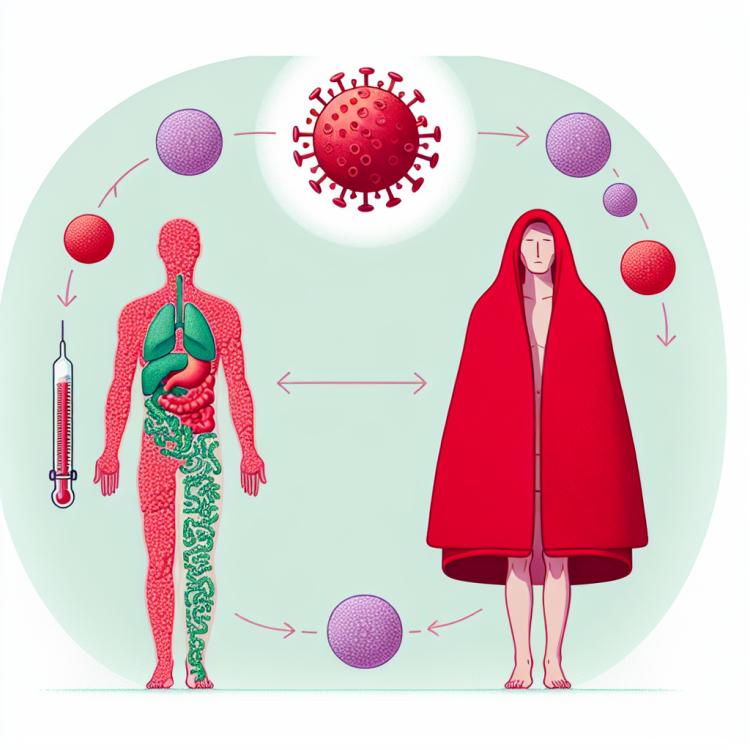
Flu: prevention, consequences, and treatment
Definition of influenza
Influenza, also known as the flu, is an acute respiratory illness caused by influenza viruses. These viruses belong to the Orthomyxoviridae family and can lead to varying degrees of severity of symptoms, including fever, cough, sore throat, weakness, and general malaise. The flu is a widely prevalent seasonal illness that can cause serious complications in particularly vulnerable populations, such as children, the elderly, and individuals with weakened immune systems.
Etiology of influenza
Influenza, caused by influenza viruses A, B, and C, is an acute respiratory disease. Influenza viruses A and B account for the majority of cases in humans. The main sources of influenza in people are infected individuals, often asymptomatic, as well as virus carriers before symptoms appear.
- Influenza Virus A: This virus is one of the main causes of influenza in humans and can cause serious epidemics and pandemics.
- Influenza Virus B: This virus can also cause respiratory infections in humans, but its role is usually less significant than that of Virus A.
- Influenza Virus C: Typically causes milder forms of the disease in humans, although it can also lead to respiratory symptoms.
- Tendency to affect the respiratory tract: Influenza is characterized by affecting the upper and lower respiratory tracts, making it a primary focus in respiratory diseases.
- Lack of sustainable immunity: As influenza viruses constantly mutate, a person may become ill even after previous contact with the virus due to changes in its structure.
Clinical picture of influenza
Flu often starts suddenly, with pronounced general malaise, weakness, headache, fever, and muscle aches. Dry cough, sore throat, and disturbances of smell and taste are also characteristic. Some patients may experience vomiting, diarrhea, or sleep disorders. In more severe cases of the flu, complications such as pneumonia, angina, bronchitis, or even thrombosis may occur.
- General malaise: sudden onset with pronounced weakness and headache.
- Fever: increase in body temperature, often accompanied by chills.
- Muscle pain: feeling of pain and fatigue in muscles throughout the body.
- Dry cough: non-productive coughing condition.
- Disruption of smell and taste: decreased or lost ability to sense smells and taste.
Experts’ views on flu treatment
Experts in the field of infectious diseases believe that for successful treatment of the flu, it is important to start using antiviral medications at the first signs of illness. Medications such as oseltamivir and zanamivir can shorten the duration of the illness and reduce the risk of complications.
Additionally, experts recommend the mandatory use of antipyretics to lower high fever and analgesics to relieve muscle aches. However, it is important not to abuse these medications, as this can cause side effects. Some specialists also emphasize the importance of rest and hydration to accelerate recovery from the flu.

Methods for diagnosing influenza
Various methods are used for the diagnosis of influenza, including laboratory and instrumental studies. One of the main methods is the detection of the influenza virus in the clinical material of the patient using molecular biological methods, such as PCR (polymerase chain reaction). Additionally, immunological tests, such as neutralization test or enzyme-linked immunosorbent assay, may be conducted to clarify the diagnosis.
The clinical picture of the disease, epidemiological data, and laboratory results help doctors establish the correct diagnosis of influenza. It is important to remember that early diagnosis allows for timely treatment and helps prevent possible complications.
- PCR (polymerase chain reaction): a method for detecting the influenza virus by amplifying and identifying its genetic material in a clinical sample.
- Enzyme-linked immunosorbent assay: a test based on the interaction of antibodies with influenza virus antigens to identify its presence.
- Immunological tests: include methods such as neutralization assay for detecting antibodies to the influenza virus in the body.
- Clinical picture of the disease: symptoms and characteristics of the illness can help the doctor suspect the presence of influenza in the patient.
- Epidemiological data: information about influenza outbreaks and contact with infected individuals can also be an important factor for diagnosing the disease.
Influenza therapy
- Antiviral drugs: In some patients with influenza, the use of antiviral agents such as oseltamivir or zanamivir can reduce the duration and severity of the illness.
- Taking analgesics and antipyretics: Using medications to lower fever and relieve pain is a standard method in the treatment of influenza.
- Bed rest: It is important to rest and stay in bed during illness to give the body a chance to fight the infection.
- Abundant drinking: Maintaining hydration helps to moisten mucous membranes and facilitate expectoration, which can ease influenza symptoms.
- Regular ventilation of the room: Fresh air helps improve gas exchange and creates a more favorable environment for recovery from respiratory infections.
Measures to prevent influenza
When in crowded places, one should avoid touching the face with hands, as this can contribute to the transmission of the influenza virus. Taking measures to strengthen immunity, including a healthy lifestyle, adequate sleep, and moderate physical activity, also contributes to the prevention of the disease.
- Vaccination: Vaccination is an effective method of preventing influenza, especially for at-risk groups.
- Hygienic measures: Regular and thorough hand washing helps prevent the transmission of the influenza virus.
- Avoiding contact with the sick: It is important to avoid close contact with people suffering from influenza.
- Use of masks: During an influenza epidemic, wearing masks helps prevent the transmission of the virus through droplets.
- Strengthening immunity: A healthy lifestyle, regular physical activity, and proper nutrition help strengthen the body’s immune system and make it less susceptible to diseases.